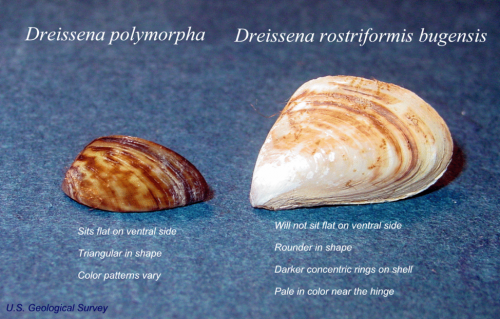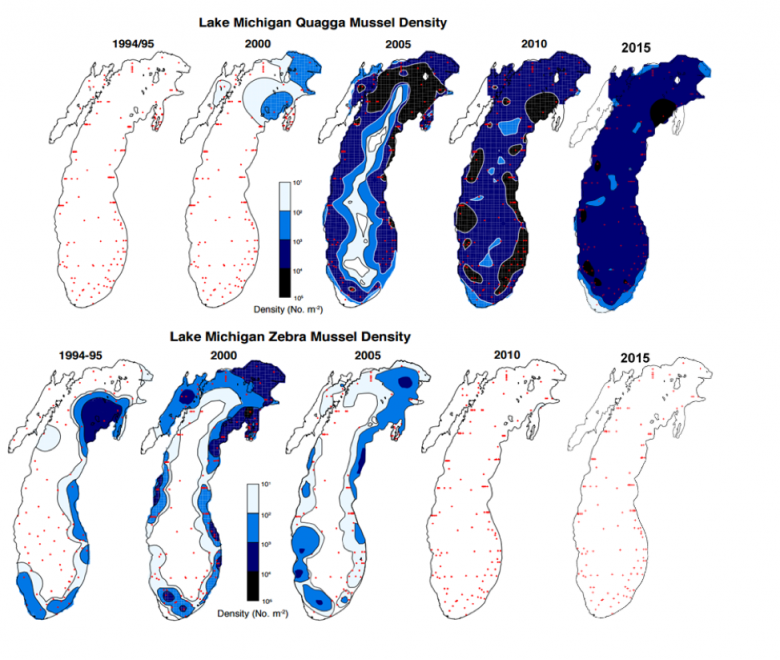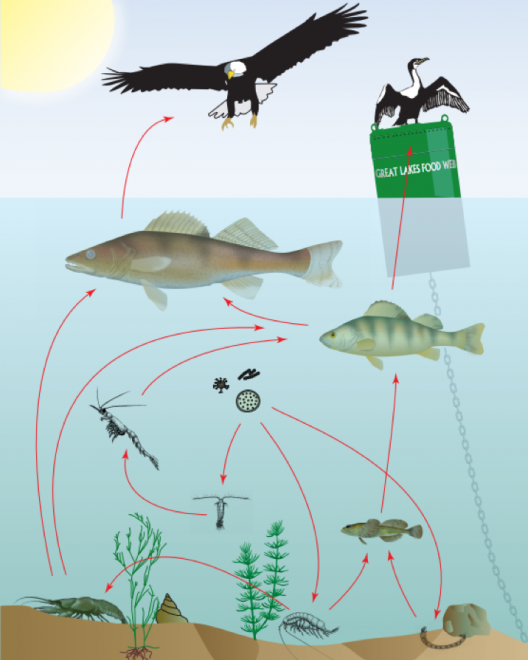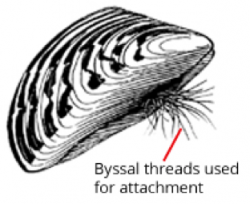By Rachel Ratliff & Mariah Cox
It has been 30 some odd years since the Dreissenid cousins made their homes in our lovely Great Lakes. Maybe you’ve heard of them, Dreissena polymorpha and Dreissena bugensis? More commonly known as the zebra mussel and quagga mussel, respectively. Since their unfortunate accidental hitchhiking in freighter ballast water these thumbnail-sized filter feeders have wreaked havoc on our freshwater system. What are those little mussels up to now? Have they integrated into the Great Lakes’ freshwater food web or processes? The Great Lakes, like any natural system, are prone to change over time. The question on our mind is, have the Great Lakes adapted to their presence and integrated them into the food web?
The dawn of a new type of invasive species
Let’s turn back the dial to when zebra mussels were brand new. It’s 1988 and Sonya Santavy is doing research in Lake Saint Clair. Quite literally on a whim, she decides to pull a sample outside of the usual area, “just to see what is or isn’t there.” The sample is devoid of typical macroinvertebrates, such as aquatic insects and worms, but instead, Sonya finds a ball of tiny rocks that are stuck together? Also, she’s pretty sure one of these might be alive! At that moment, Santavy had just unearthed a ball of zebra mussels, thus marking the first scientific recording of these invasive mussels in Great Lakes waters [1].

It is unlikely that these were the first zebra mussels to make a home in the Great Lakes Basin, but finding them at random was akin to the calm before the storm. Following her discovery, ecological chaos ensued. The mussels colonize densely on water pipes to the point of blockage, they hide away in recreational boats to travel from one body of fresh water to another, and hot dang those shells are sharp. In favorable conditions, these little buggers can colonize as densely as 100,000 mussels per square meter [2].
Now, if we grabbed any Great Lakes native off the street and asked which Great Lakes invasive species is the densest and most dangerous, we can guarantee that at least 8 out of 10 would say the zebra mussel. Hot on the heels of the famous zebra, quagga mussels were first found in 1989 along Lake Erie. The two species are strikingly similar in appearance and it takes a trained eye to tell the two apart. The classic zebra mussel is flat along the bottom and symmetrical when stood up. The quagga has a rounded bottom, a slightly curved “nose,” and is typically larger than the zebra (Fig. 1). Further, quagga mussels can thrive in colder deeper waters [3]. This characteristic has allowed quagga populations in Lake Michigan to explode far beyond anything we have seen with the zebra mussels (Fig. 2).

The root of the issue
Both of these mussels are voracious filter feeders capable of filtering as much as one liter of water per day when fully grown [1,4]. They are hungry for plankton, small animals that serve as the base of our freshwater food web (Fig. 3). Plankton are a primary food source for many Great Lakes animals including macroinvertebrates, mollusks, and even some small fish. The mussel’s gluttonous eating habits mean there isn’t always enough plankton to go around and other species, including mussels native to the Great Lakes, are being outcompeted.
As you may have noticed, the water in parts of the lake is as clear and as blue as some beachy tropical paradise destinations. Sure this may look more friendly to swim in, but it’s not necessarily a good thing. Increased water clarity is allowing some potentially toxic blue-green algae to bloom on the lake bed [7]. Not only are the mussels eating the algae and plankton, they are picky eaters too!

A changing ecosystem
One characteristic of an invasive species is that it does not have to concern itself with predation. The typical top dogs in the native food web have no idea what to do with some introduced species. Most of them aren’t looking for dinner that causes them a headache, so they will pass on an exotic species in favor of one more familiar to them. However, this isn’t always the case.
Some species that are introduced into a native system are fed upon by native predators. What makes an invasive species less likely to be preyed upon is difficult to tell, that is why we need to be vigilant in our efforts to minimize accidental introduction. In fact, our Dressenids have come to fear a few organisms in the lake.
First is the round goby (Neogobius melanostomus). This froggy looking fish is also an invasive from the same region as the mussels so it is no surprise that they are happy to make a quick snack of the little bivalves. Next is the rusty crayfish (Orconectes rusticus). This crustacean is also an invasive from south of the Ohio River basin. Their large pinchers make short work of the mussel’s protective shells. Finally, a surprise contender, the pumpkinseed fish (Lepomis gibbosusa) also eats zebra and quagga mussels [4]. There have been anecdotal accounts of other species snacking on Dressenid mussels but without peer-reviewed publications, we cannot make any concrete assertions.
A study done by Naddafi and Rudstam in 2013 showed that just the presence of zebra and quagga predators lead to changes in the bivalves’ behavior [4]. Ultimately, these changes slow the feeding rate of the mussels and preserve some of the algae and plankton populations.
Escaping predation
Unfortunately, these predators are typically only successful in eating the invasive mussels for a relatively short period of the mussel’s life span. Gobies, for instance, are called gape-limited predators. This is a hilarious way of saying they can only eat stuff that fits inside their mouth. Full-grown gobies typically max out at less than 10 inches and do not consume mussels over 0.7 inches long. There is a similar trend in crayfish and pumpkinseed predation; larger mussels are more difficult to consume and are therefore passed over [6].
Size is one of many factors that affect whether or not eating a mussel is worth the trouble. For instance, adult Dressenids have a much stronger adhesion system than their younger siblings (Fig. 4). Trying to yank an older mussel free from their chosen surface is not an easy task. Not even Dwayne the Rock Johnson is trying to work that hard for a midnight snack.
Stealth is also a factor in Dressenid survivorship. Just like on land, if prey can successfully hide from their predator it is likely they will live to see another day. Small mussels can tuck themselves under rocks or even between larger mussels to avoid being eaten.

Figure 4. Mussels use byssal threads to adhere to surfaces including rocks, boat props, water pipes and sediment. It takes a few hours for the hairs to attach firmly using a mucosal glue. Image courtesy of Minnesota Sea Grant.
The future of our Great Lakes
From shifts in the food web to clearer waters and the loss of many native mussel species, these fingernail-sized exotic mussels leave a huge handprint on the ecosystem. Scientists all over the basin and beyond are working to find a way to eradicate the filter feeders from the lakes. With community densities in the billions and no sign of slowing down, it appears that these mussels are here to stay.
One should not fret for the Great Lakes, however. As stated previously, in any system change is inevitable. If we compare the properties of these lakes to other freshwater bodies in the world they are actually quite young. Through adaptation, the Great Lakes will see and survive much change throughout the span of our species’ reign. Just recently on one of ISEA’s Schoolship overnight trips, some students found a caddisfly larva who made its case out of tiny living quagga mussels (Fig. 5)! Caddisflies are one of the many flying insects that begin their life cycle underwater. Some species build portable cases out of a naturally spun silk reinforced with pebbles, rocks, or twigs. This particular larva had chosen young quaggas to wedge into its case, thus limiting the invasives ability to filter feed. We were all in awe of this small insect who unknowingly prevented the growth of at least 200 invasive filter feeders. The caddisfly was returned to the lake in hopes that it would live to pass its inventive genes on to another generation.

Generations. That is how long adaptations take. We need to be asking ourselves, “How can humans reduce our negative impact on the system to allow these generational changes to occur?” And most importantly, “How can we prioritize the prevention of other species being accidentally introduced into the Great Lakes, which are home to thousands of species, native and nonnative alike?” It is our responsibility as humans and as leading ecosystem engineers to ensure the long-term health of this critical resource.
This blog has been written by Rachel Ratliff, a summer educator for Inland Seas Education Association, and edited by Mariah Cox, the summer 2019 communication intern. Rachel obtained her degree in natural resource management with a minor in biology from Grand Valley State University. She first began her journey with ISEA as an education intern in the summer of 2018 and has a passion for experiential education as well as public outreach and communication.
References
- Egan, Dan. “How Invasive Species Changed the Great Lakes Forever.” A Watershed Moment | Great Lakes at a Crossroads – How Invasive Species Changed the Great Lakes Forever, Journal Sentinel, 26 July 2014, archive.jsonline.com/news/wisconsin/how-invasive-species-changed-the-great-lakes-forever-b99297128z1-267010971.html/.
- Cary Institute. https://www.caryinstitute.org/sites/default/files/public/downloads/curriculum-project/zebra_mussel_fact_sheet.pdf
- Metz O, Temmen A, Von Oheimb K, Albrecht C, Schubert P, Wilke T (2018) Invader vs invader: intra- and interspecific competition mechanisms in zebra and quagga mussels. Aquatic Invasions 13 (4): 473-480.
- Naddafi R, Rudstam LG (2013) Predator diversity effects in an exotic freshwater food web. PLOS ONE. www.plosone.org.
- Djuricich P, Janssen J (2001) Impact of Round Goby Predation on Zebra Mussel Size Distribution at Calumet Harbor, Lake Michigan. Journal of Great Lakes Research 27 (3): 312-318.
- Naddafi R, Rudstam LG (2014) Does differential predation explain the replacement of zebra by quagga mussels? Freshwater Science 33 (3): 895-903.
- Bloch, Jim. “Invasion of the Great Lakes: Quagga Mussels Least Known, Most Dangerous Invader.” News, News-Herald, 3 Nov. 2016, www.thenewsherald.com/news/invasion-of-the-great-lakes-quagga-mussels-least-known-most/article_4eb454e3-7f11-5335-99bf-d3dd0a8e6ded.html.
Inland Seas Education Association (ISEA) is a 501(c)(3) nonprofit organization whose mission is to inspire Great Lakes curiosity, stewardship and passion. Through hands-on, experiential learning activities, people of all ages gain an appreciation for and personal connection to our lakes, leading to a desire to care for and protect them. For more information about our schoolship programs, data, or public sails, please visit www.schoolship.org.